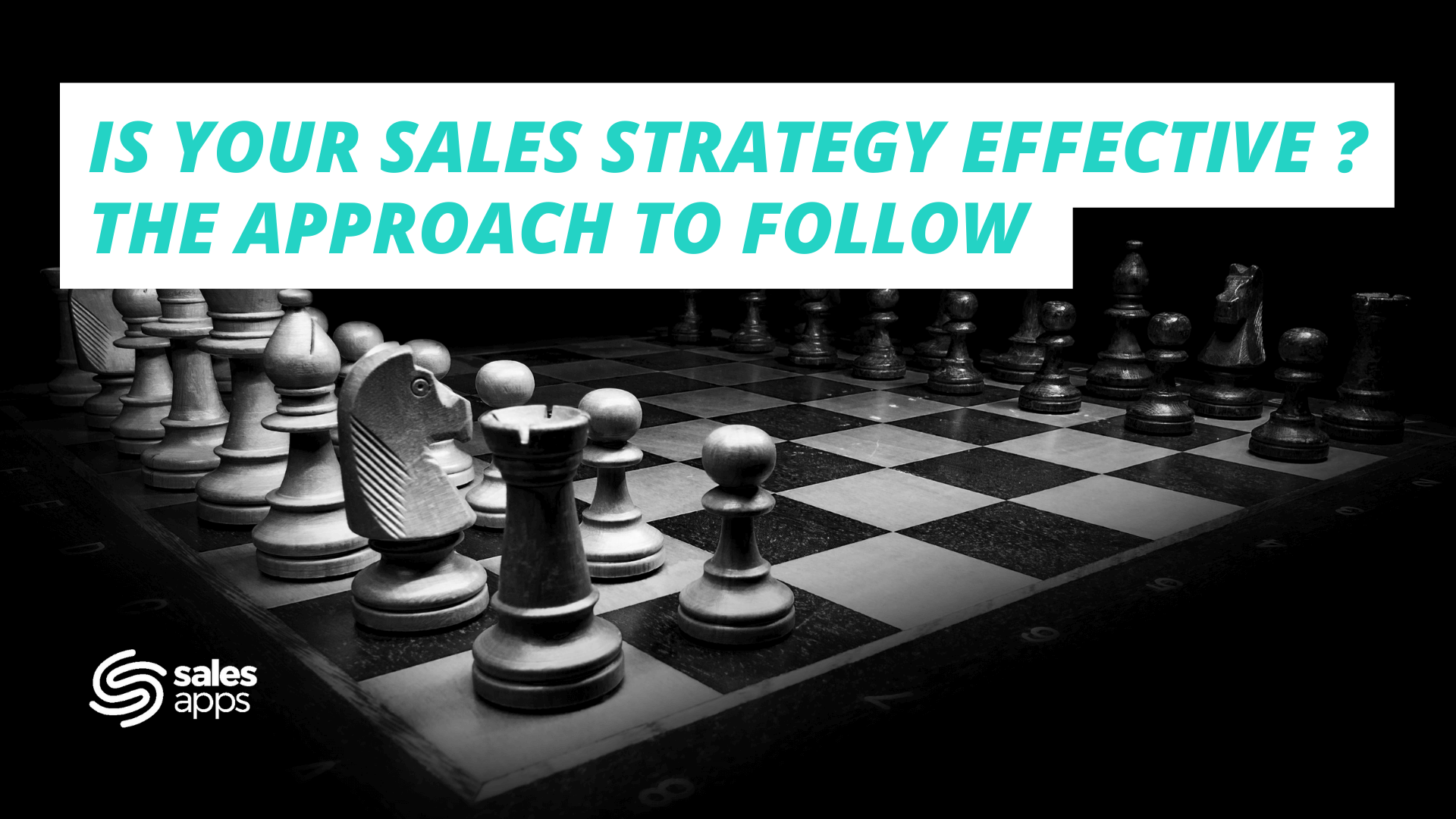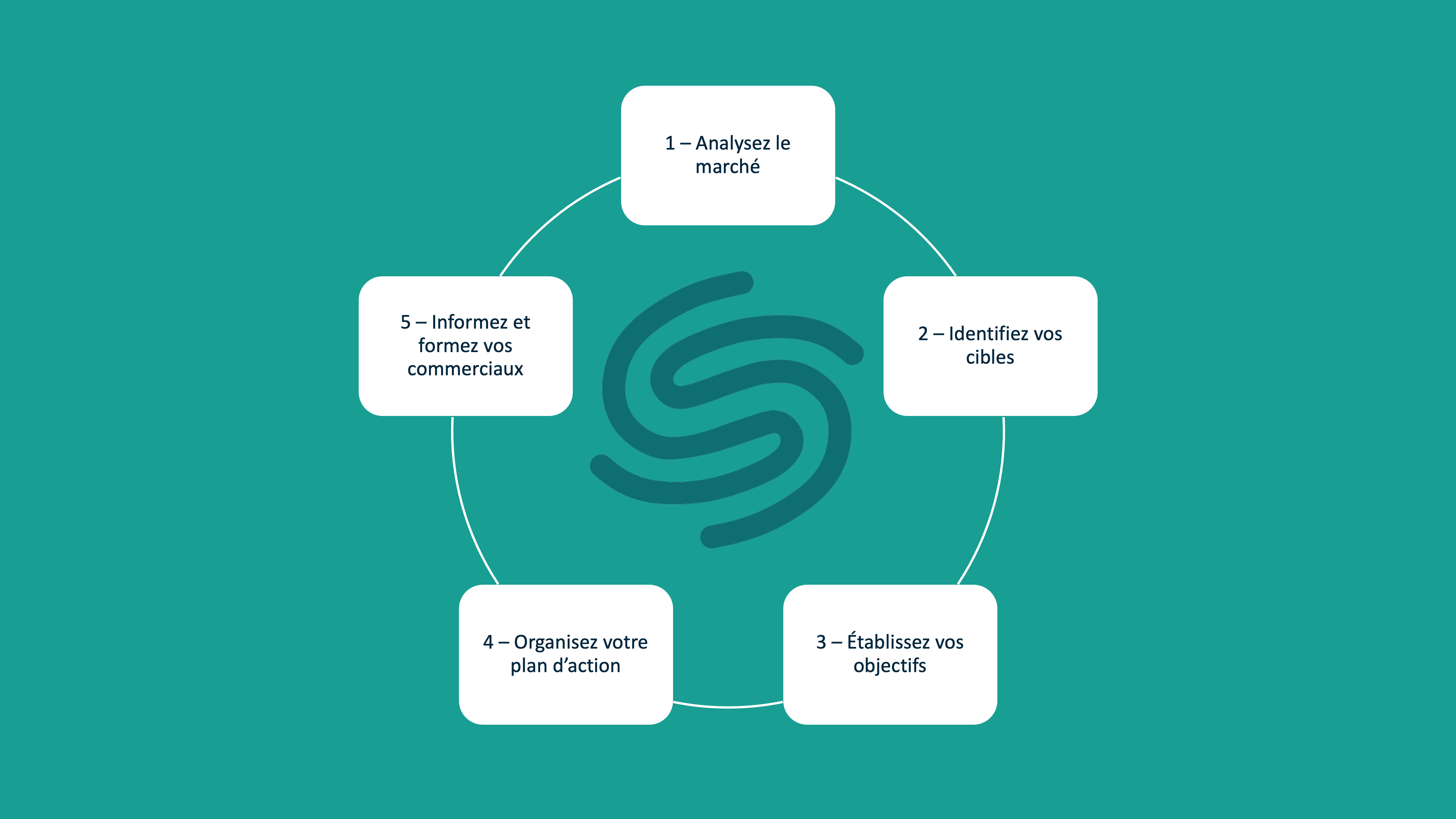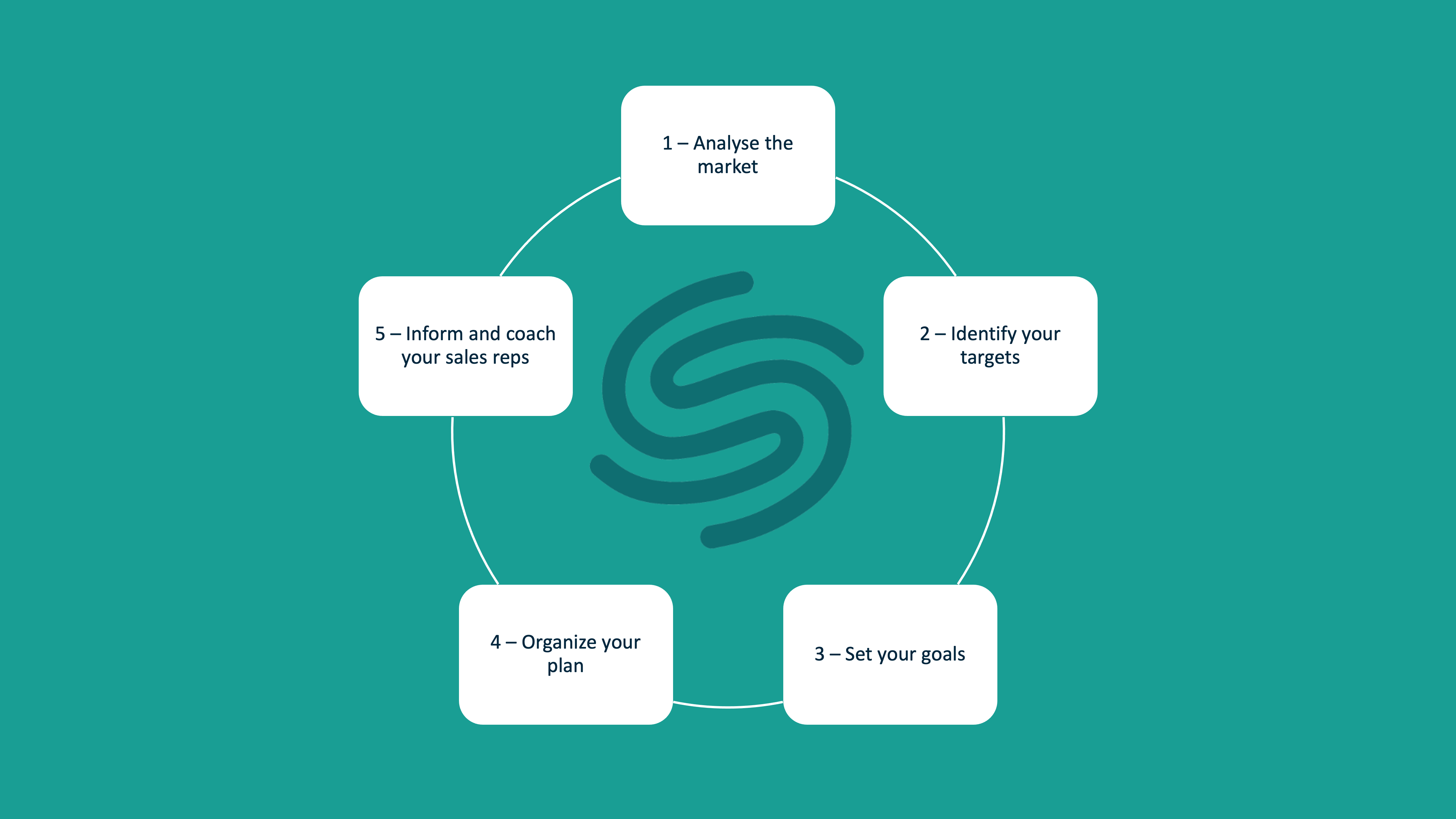
Blog

How do you define your sales strategy?
A sales strategy consists of defining and implementing sales and marketing actions to achieve the objectives defined by a company's management. This includes identifying the market and your target, selecting the products/services to be promoted, establishing a pricing strategy, choosing distribution channels, and implementing various tactics to effectively penetrate your market. The aim of sales strategy is to develop your company's position in the market, increase sales and margins, and sometimes defend your position.
A sales strategy is built around 5 pillars:
- Environmental analysis (SWOT and PESTEL analysis)
- Identifying your sales target
- Setting up your marketing mix using the 4 P's (Product, Price, Promotion, Place)
- Setting SMART objectives
- Track and analyze your KPIs
The importance of an effective sales strategy
La mise en place d’une stratégie commerciale est essentielle pour réussir sur votre marché. Une telle stratégie permet de mobiliser l’ensemble de vos ressources (techniques, humaines, financières…) pour l’atteinte de vos objectifs. Une stratégie commerciale bien conçue vous permet non seulement d’établir un plan d’action précis mais il facilite également votre prise de décisions. Guidé par les indicateurs de performance (KPI) que vous aurez définis pour évaluer votre performance, vous serez en mesure d’évaluer votre avancement au fil du temps, de faire preuve d’agilité face à l’évolution du marché et de l’environnement concurrentiel, et donc d’optimiser vos résultats !
How to define your sales strategy step by step?

Here are the 5 steps to defining an effective sales strategy.
1 - Conduct a strategic market analysis
Market research is, par excellence, the information base you need to launch your sales strategy. It is based on two essential marketing tools:
- The SWOT matrix (Strengths - Weaknesses - Opportunities - Threats)
- The PESTEL method (Political, Economic, Sociological, Technological, Environmental and Legal)
As with the analysis of your environment, competitive intelligence is essential if you are to propose a high-performance offer, whatever your strategy (value creation, aggressive or top-of-the-range price positioning, etc.). By studying your competitors within the framework of a SWOT matrix, your sales strategy becomes more relevant and effective. You need to distinguish between two types of competitor:
- Directs that offer the same products as yours to meet the same needs
- Indirect, those whose offer is different from yours, but meets the same needs
In addition, always keep your finger on the pulse of the market and be on the lookout for new comers. To find out more about your competitors: visit their websites, go and see them at trade fairs, watch their conferences and webinars, read the latest news, consult customer reviews on platforms such as G2 or Capterra. This approach will enable you to consolidate your external diagnosis and identify :
- Market leaders
- New entrants
- Sales opportunities
- Best practices to adapt
All the information derived from this study will enable you to identify your strengths and weaknesses, as well as those of your competitors, and to define your immediate competitive advantages, or those on which you wish to position yourself over time. The aim of this approach is to identify your added value in relation to your competitors, and to provide you with a better understanding of your environment, its opportunities and threats. In addition to the SWOT matrix, which provides an internal and external diagnosis of your company, the PESTEL model will help you identify in detail the environmental factors that could influence your company's objectives. This analysis will enable you to determine your key success factors in the marketplace.
2 - Identify your targets
Next, identify your target! Start by defining the type of company you want to target, taking into account criteria such as sales, number of employees, business sector and location. Then identify the functions you want to reach within these companies (CFO, Human Resources Manager, Marketing Director...).
We recommend segmenting your sales approach by defining a core target and secondary targets. This will enable you to ensure the implementation of relevant sales actions. You can use this Buyer Persona model as a basis for creating your ideal customer.

Lexicon
- Typical profile : The type of functions usually performed by people corresponding to the Persona
- Profile bunker: All the wrong profiles to avoid
- Usual objections: The type of questions usually formulated by the Persona
- Role and Stakes: Role played in the project or opportunity, and the Persona's usual stakes.
- Professional motivations: Personal interest in the project's success. How can your product/service support his or her personal professional ambitions?
- Technological expectations: Functionalities expected in the application. Persona evaluation criteria.
- Influence: Maturity (knowledge of the subject you are addressing), Decision (Decision-making ability), Weight (Weight in the final choice), 1st contact (Contact as 1st contact for the project), Access (Accessibility of the contact)
3 - Set your goals
Once you've completed the above steps, you can focus on your objectives sales reps. These will serve as benchmarks to guide and evaluate all your sales actions. Use the SMART method to set objectives for your sales teams. Widely used in business, this method helps you define specific, measurable, achievable, realistic and time-bound objectives.
Here are a few examples of well-formulated objectives:
- Increase annual sales generated by the sales team by 5% in Q1
- Generate "100" monthly leads via the blog by October1
- Achieve 95% customer satisfaction by the end of the year
- To be in the top 3 in the market at 31/12
It's important to avoid working on several objectives at the same time! Beyond two or three, the sales strategy loses effectiveness. If necessary, it's better to prioritize objectives rather than accumulate them or define them over shorter periods.
4 - Organize your action plan
The marketing mix is an important tool for a company that is just starting out, or is in the midst of a strategic review of its offerings and sales development. Although some people now talk about 7Ps or even 10Ps, we're going to focus on the essentials, namely the 4Ps for preparing yoursales action plan.
Product: What is the product/service you are launching on the market to meet a specific need? How does the company distinguish itself from its competitors in terms of value creation? The product has several characteristics: an image (reflecting the company's values and identity) and a function( productperformance ).
Price: What price are your buyers willing to pay for your product/service? Your selling price must be in line with the expectations of your target audience, in harmony with the price ranges offered by your competitors, while having the potential to generate profits according to your financial projection.
Place: What is your distribution model? You can adopt one of the following approaches in your business development strategy: Single-channel (a single distribution channel), Multi-channel (several physical and/or virtual sales channels: websites, mobile applications), Cross-channel (crossing several sales channels) and Omnichannel Distribution (several sales channels simultaneously).
Promotion: How do you promote your product/service? Your sales approach can capitalize on different acquisition channels: Content marketing, Email marketing, Display ads, SEO, Partnership, Referral marketing... You can then draw up a list of actions according to your typical customer and your objectives.
5 - Inform and train your sales reps
La formation de vos commerciaux est une composante essentielle à la réussite de votre stratégie commerciale. Quand on sait que 24% des entreprises américaines ont des problèmes de compétences commerciales (ATD), on peut s’interroger sur les thématiques de formation des nouveaux entrants et sur les méthodes utilisées pour ce faire. Voici les points clés sur lesquels votre Manager/Directeur commercial devrait orienter votre formation dès leurs arrivés :
- Presenting and "selling" strategy. A well-understood strategy is one to which we adhere, and to which we can relate each of our actions.
- Product/service understanding: familiarize your sales team with the product/service being marketed.
- Knowledge of the market and the players: make sure that your sales reps has in-depth knowledge of your industry and the players involved.
- Élaboration d’un argumentaire de vente : montrer leur comment segmenter leur approche commerciale et guidez vos commerciaux dans le développement d’un argumentaire de vente percutant. Vous pouvez aussi organiser des mises en situation afin de les rendre plus à l’aise dans leur discours commercial.
- Sales process: explain the sales process from prospecting to product demo to closing, show how to identify the buyer's needs, handle objections and negotiate effectively.
- Use of technological tools: make sure your sales reps are comfortable with CRM, prospecting and lead management tools.
La meilleure façon d’accélérer la montée en compétence de vos nouveaux entrants, de renforcer leur maîtrise des offres/services et d’améliorer leur argumentaire de vente en rendez-vous, c’est d’utiliser une application Sales Enablement.
How to implement your sales strategy?

1 - Create a letter of objectives in line with your sales strategy
The sales teams' letter of objectives must reflect your overall sales strategy and its implementation through your action plans. Otherwise, not everyone will be pulling in the same direction. It is generally defined on an annual basis, and can be broken down by half-year or even quarter. It must be clear, perfectly legible and not open to interpretation. The objectives set must therefore be easily understood and measurable by the sales force itself, if they are to serve as a guide for Sales' day-to-day actions. A source of motivation, the letter of objectives must also encourage the sales force to achieve and surpass their targets.
2 - Track and analyze your performance using tools
Le CRM demeure l’outil par excellence pour surveiller avec précision votre performance commerciale. En plus de générer des rapports de vente précis en fonction des indicateurs de performance (KPI) que vous avez sélectionnés, il vous offre une vision 360° de vos clients. Une vraie source de connaissance qui enrichit votre compréhension des clients et facilite l’exécution de vos actions commerciales. En complément du CRM et pour aller plus loin dans votre analyse, nous avons développé Salesapps Board ! Cette interface vous permet de mieux piloter votre activité commerciale puisque vous allez pouvoir mesurer des métriques non possibles avec le CRM. On peut évoquer notamment les parcours de vente utilisés par le commercial, les contenus marketing présentés en rendez-vous ou encore ceux partagés lors des relances commerciales (contenus partagés, lus et non lus). Un moyen pertinent pour l’équipe marketing qui lui permet d’améliorer continuellement sa stratégie de création de contenus. L’intérêt de cet outil réside aussi dans sa capacité à vous aider à identifier les bonnes pratiques d’un commercial performant et à les appliquer au reste de votre équipe de vente.
3 - Adapt your actions and start again
Grâce au traitement des données issues de vos dashboards et des remontées terrains, vous gagnez en visibilité sur l’efficacité de votre stratégie commerciale déployée, tout en étant en mesure d’ajuster vos actions en fonction de leur résultat. Il n’a pas de recettes magiques mais que des bonnes pratiques ! Lancer vos actions, tester les et recommencer jusqu’à pouvoir constater des changements au niveau des KPIs que vous tracker.
Est-ce que votre stratégie commerciale est clair pour l’ensemble de vos équipes ? Découvrez-le maintenant ici

FAQ
What is a sales strategy? The sales strategy is derived from your general strategy, and refers to all the marketing and sales actions your company takes to achieve its defined objectives.
What are the different sales strategies? There are different types of sales strategy: focusing on key accounts, favoring niche markets, expanding our offering to existing customers, adopting a freemium sales strategy, or responding to calls for tender, for example.
What is the first step in a sales strategy? The first step in a sales strategy is to carry out an in-depth analysis of your market. You can use the SWOT and PESTEL matrices to help you do this.
What is the aim of a sales strategy? The aim of a sales strategy is to increase the number of customers you have, and thus the sales of the products/services you offer.
How do you set up a sales strategy? Proceed in stages, starting with an analysis of your market, the creation of your personas and your sales action plan (marketing mix), your objectives sales reps and then the training of your sales team for the operational part.
Which KPIs should you analyze to assess the performance of your sales strategy? Whatever the current state of your strategy, you need to use KPIs to measure your sales performance: number of new customers signed, number of appointments sales reps made, conversion rate, sales cycle time, customer acquisition cost, number of new customers vs. old customers...



